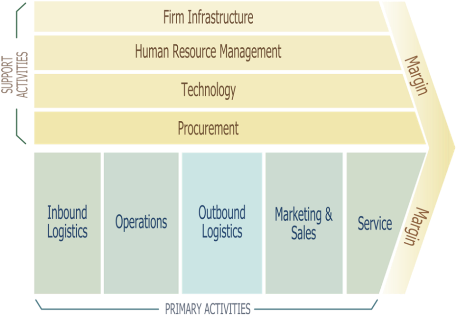How Do Value Chains Work?
The basic premise of a value chain is that it can be used for improving a company's efficiency and creating better margins. In other words, it’s how the business will organize itself to deliver the best products and services while also increasing profitability.
The most widely used model for accomplishing this is Porter's value chain. This is the framework that helps businesses identify and group their functions into two main groups of activities: primary and support.
Primary and support activities are common among most businesses and can be further described as follows.

Primary Activities
Primary activities are those within a value chain that can be directly attributed to the creation of a product or execution of a service. They can generally be classified into five main categories.
● Inbound logistics: Activities such as the receipt, inventory, and long-term storage of raw materials or purchased items.
● Operations: Any activity related to taking raw materials into a final saleable product.
● Outbound logistics: Activities such as sorting, packaging, distribution, and shipping to the customers.
● Marketing and sales: Activities that promote the sale of the product or service. This includes promotional campaigns, advertising, and setting price points.
● Service: Any activity related to customer service after a sale has been made. This may include installation, training, repairs, warranty, etc.
Support Activities
Support activities (also sometimes referred to as secondary activities) are those activities that are meant to assist and improve the primary activities. Again, the overall goal is that they should make the company more competitive.
● Procurement: Activities that support getting the best prices, proper equipment, and anything else it needs for efficient operation.
● Human resource management: Activities that lead to finding the right talent, providing the appropriate training, and finding ways to motivate or reward them.
● Technological development: Activities related to the management and processing of information.
● Infrastructure: Activities that give a company its general structure such as financing, planning, management, etc.
Value Chain Example: Amazon
A good example of a company that utilizes a value chain within its organization is the online retail giant Amazon. Since 1994, Amazon has grown from an Internet bookstore into one of the most widely used marketplaces for virtually any type of product.
Focusing on its primary activities, we can see why this is true for Amazon.
● Inbound Logistics: The company relies on JIT (just in time) suppliers, FBA (Fulfilment by Amazon) merchants, and inventory within its 1,137 fulfillment centers all around the world.
● Operations: Amazon doesn't make any physical products. Their product is the fulfillment of the customer's order in a timely manner and at a competitive price. Amazon has figured out how to do this efficiently by creating a robust online marketplace and digitally fulfilling those orders - sometimes with this use of autonomous sorters at its fulfillment centers.
● Outbound Logistics: With its vast network of fulfillment centers and FBA merchants, Amazon has the ability to package and ship items as quickly as the same day. It also employs its own delivery service to bypass traditional shipping services.
● Marketing and Sales: Customers know that ordering something on Amazon typically means a low price and fast delivery. Amazon has also positioned itself to appear in nearly every search engine result related to a product and partners with millions of affiliate marketers.
● Service: Amazon customers are assured that if something doesn't meet their expectations, returns are easy and hassle-free.
